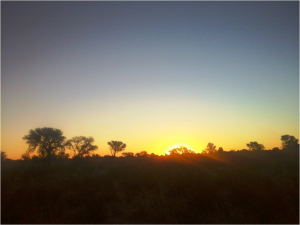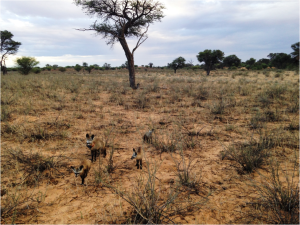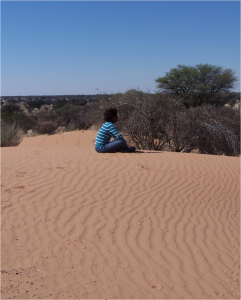Serene, would be how I describe this desert atmosphere where I do research. We are far from the hustle and bustle of city life, surrounded only by a small and sparse community of farmers and workers. The nearest shop is almost 30km away and traffic is virtually non-existent. With no television and very little distraction, it can get so quiet that you hear a pin drop, and I revel in the many advantages that this peace brings. For starters, it’s a book lover’s paradise. There’s nothing like soaking up the Kalahari sunset with a good book in hand. And there’s more: this tranquility offers me room to reflect on my life’s journey, both academically and otherwise. Perhaps the best part of it all is that I’m exposed to a friendly, hardworking and accomplished research community that is very generous of their time and knowledge.

So what does my fieldwork entail? To recap, I’m collecting data to shed light on why female batties (aka bat-eared foxes) neglect their maternal duties. There’s a healthy population of batties in the reserve where I live, coupled with plenty of other wild life. The first task is habituation. This means getting batties familiar enough to your presence for you to follow them around without influencing their normal behaviour. They are notoriously shy animals and it takes plenty of patience (think months!), raisins (they absolutely love it) and skills to approach without startling them. After habituation, data collection begins in the form of recording behaviour on a tablet and collecting faecal samples for laboratory hormonal analysis. As you’ve probably figured out by now, we work individually and mostly at night since batties are mainly nocturnal animals. But working at night can be good, just ask diurnal researchers how hot it gets in the Kalahari during summer!
The breeding season, which runs from October to December, is a critical period for my research as I eagerly await surprises of new brood. Last December, despite drought setbacks, our project had its very first litter of pups by a vixen named

Bertha. Mother and pups took us on a roller coaster ride of frequent den changes, necessitating regular visits to keep track and onsite monitoring with the aid of cameras. These visits were also useful for pup habituation. On one such visit, things started out fine as I located all pups at a new den close to the previous one. I proceeded to habituate them, kneeling down for a close up view of their behaviour and interactions. Forty-five minutes into habituation, the hair on the back of my neck suddenly started to rise… I instinctively turned around and locked eyes with a lone wildebeest bull.
Frightened, I jumped up and the pups scurried down the den. The bull stood still and started snorting at me. I knew that was a bad sign. What to do?! In a panic, I picked up my backpack and started walking slowly backwards in a feeble attempt to escape. It snorted all the louder, shaking its head in the process. I mouthed a couple of expletives. The lack of tall trees within immediate vicinity didn’t help, nor did my bright orange T-shirt. Could this bright shirt be as provocative as those red flags used by Spanish matadors in bullfights?!! And then… of all the songs that could soothe me in this dire moment, Michael Jackson’s “Thriller” came to mind. Great! So “No one’s gonna save me from the beast about to strike, ‘cause this is …THRILLER!” MJ lost a fan in that dark moment. Finally, the bull started to stir and turn away from me. Maybe I didn’t look appetizing enough?
Just then I heard a rustling noise behind me. Imagining the worst, I spun around, only to find Bertha’s new beau at the top of a dune watching me, ears propped up like two mini fans. He appeared a bit more wary of me than the gigantic beast wandering slowly away. Bertha was making her way up the top too. I breathed a deep sigh of relief at my lucky escape. Many researchers have not been that fortunate, and the dangers of field work are not limited to the natural sciences. Mind you, it’s not only large mammals one has to watch out for, venomous creepy crawlies thrive here too, such as black widow spiders that hide beneath toilet seats, scorpions with shoe-addiction and snakes that slither into shower blocks at night.

You bet I never go out without my walkie talkie for emergency calls and bandages for first-aid, especially after I nearly stepped on an adder…

This is a great story, Kea! Reminds me of my Kalahari days on the meerkat project. I still miss the crisp morning air and the sunsets, and the gnarled Boschia albitrunca trees… and… and… and…
LikeLike